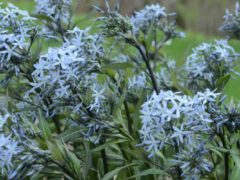
dwarf false indigo
Amorpha nana
Bright green leaves are topped by showy purple flowers with bright red stamen that give … Continued
Drought-tolerant and drought-resistant plants may still need supplemental water from time to time, but they can survive periods of dryness without dying.
Drought-resistant plants like cactus, hens and chicks, and sedums can go for very long periods without water and do not tolerate poorly drained locations. Drought-resistant tropical plants grown indoors in winter like cactus, Sansevieria, Echeveria, and other succulents sometimes fail due to overwatering.
Drought-tolerant plants grow in many textures and sizes and have different adaptations that help them get through periods of drought:
The latter two types of plants are drought tolerant once established because any new planting, regardless of drought tolerance, needs to be watered during the first growing season to allow roots to reach the depths needed to access moisture during dry periods.
It’s also important to note that survival may not mean that the plant will look its best during this time. Watering weekly for a longer period of time will result in the best-looking gardens with the highest tolerance for drought. During the hottest, dryest times in summer, watering deeply twice a week is recommended. These less frequent waterings will encourage root systems to expand, making it easier for plants to access moisture when their environment is dry.
Winter drought has become a bigger problem in recent years as snowfall declines. Evergreen plants are especially vulnerable during winter drought because their foliage continues to shed moisture while dormant deciduous plants have shed their leaves and can conserve moisture in woody stems and underground. Watering shrubs and trees in winter on days when the temperature allows (above freezing) will help ensure their healthy return in spring.
Here are some drought-tolerant and drought-resistant plants to grow—

Amorpha nana
Bright green leaves are topped by showy purple flowers with bright red stamen that give … Continued

Amorpha canescens
This native shrub grows in woodlands and prairies. 4-8″ spike-like clusters of tiny, bluish-purple flowers … Continued

Amsonia tabernaemontana ‘Blue Ice’
Gorgeous navy blue buds in late spring open to vivid periwinkle blue, star-shaped flowers larger … Continued

Amsonia hubrichti
Perennial Plant Association 2011 Perennial Plant of the Year! Pale blue flowers cover fine-needle-leaved, dense, … Continued

Amsonia tabernaemontana
Large, multi-stemmed clumps are crowded with narrow, oval leaves which turn golden-yellow in the fall. … Continued

Amsonia tabernaemontana ‘Storm Cloud’
‘Storm Cloud’ is an exciting new native plant selection with spring foliage emerging near-black and … Continued

Andropogon gerardii
This colorful, robust hardy grass is NATIVE FROM CANADA TO MEXICO. Tall foliage turns light … Continued

Andropogon gerardii 'Blackhawks'
A cultivar of native prairie grass that has taken the gardening world by storm. Foliage … Continued

Anemone sylvestris
Nodding white blooms in early to mid-spring and again in fall over lustrous dense green … Continued

Anethum graveolens
Delicious, easy to grow, tangy dill provides both seeds and greens to flavor many foods. … Continued

Angelonia angustifolia
A long blooming annual with outstanding branching habit and strong stems that also make great … Continued

Antennaria plantaginifolia
Soft, gray foliage is arguably the best ornamental feature of this native perennial. Useful as … Continued